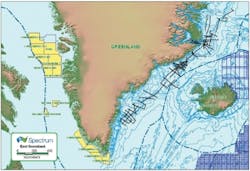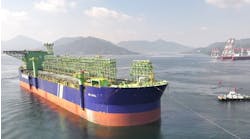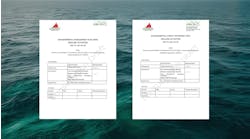New well control barriers help operators tackle offshore challenges
Closed-loop drilling decreases likelihood of well-control incidents
Brian Grayson
Weatherford International
Kicks and fluid losses are common obstacles to drilling offshore, especially in deepwater where (even in the best case scenarios) some 20% of rig time can be spent curing hazards.
In some instances, these kick or loss events can cause setbacks that can double or even triple rig time and could escalate to well-control incidents. Costly delays and high risk exposure dictate the need for advanced technology and drilling methods to ensure the viability of challenging offshore operations.
Conventional well-control strategies include casing, fluid programs, and other barriers to well control incidents in the well design and BOP, and other mitigation procedures that help minimize the impact of an incident should one occur. Beyond upfront engineering and reactive responses, there were no other lines of defense against well-control events in traditional methodologies.
The advancement of closed-loop drilling successfully bridged that gap by providing engineers with the ability to precisely measure and manage minute fluid influxes and losses before they develop into an incident. This early warning and management capability serves as an additional barrier and effectively reduces the need to apply traditional secondary well-control methodologies.
Recent improvements to closed-loop drilling technologies are making it even more possible to address long-standing issues with maintaining safe and efficient operations offshore, thereby broadening the range of reservoirs that can be drilled and produced.
Expanding operational limits
Closing the loop resolves many problems that traditional open mud returns cannot, such as minimizing issues associated with fluid circulation and enabling drilling in even more narrow windows. Simply put, open circulating is unable to meet the operational and economic demands of modern wellbore construction.
In contrast, closed-loop circulating offers a scalable set of capabilities that allows for precise wellbore pressure management along with the ability to proactively “listen to the well” and ascertain real-time downhole pressure events. Ranging from early kick and loss detection to wellbore control and management, closed-loop drilling methods are being applied across a broad scope of applications to enhance safety, efficiency, and drill-ability.
Closing the loop entails capturing and redirecting what is otherwise the free flow of drilling fluids, cuttings, and hydrocarbons from the drill pipe-casing annulus. Instead of uncontained flowing mud, the result is a highly sensitive instrument that provides precise, high-resolution, and actionable, real-time pressure and flow data. Engineers can peer into a sensitive window on the wellbore to conclude whether a threatening situation is present and craft a response accordingly, without interfering with the rig's conventional BOP and fluid handling systems.
Closed-loop drilling techniques can be accomplished with a small equipment spread comprised of a few basic components. Most of the tools used to close the loop are standard proven rig equipment, including rotating control devices (RCDs), flow-metering technologies, drilling choke manifolds, and downhole isolation valves. Key enabling technologies for closed-loop systems are advanced built-for-purpose marine RCDs, and data acquisition instrumentation and software that combine the tools in a system.
Listening to the well for early kick loss and detection is the most basic function of closed-loop drilling. The next frontier for advancing capabilities is to move from manual choke manifolds to automated systems to add even more precision to closed-loop drilling.
Integrating with riser
RCDs are common technology that facilitate closed-loop systems by enabling safe containment and diversion of a fluid and gas kicks to a return system. By capping and redirecting annular flow under the rig floor, away from the crew and surface equipment, RCDs play a critical role in safe and efficient rig operations and well construction by enabling timely acquisition of information for fast event identification.
Automation is the next step in wellbore pressure management. MPD systems installed with an automatic choke can use internal algorithms to identify what is occurring downhole and react automatically.
To accommodate the requirements of offshore operations, more sophisticated RCD models are being designed specifically for the unique challenges of these environments. Weatherford recently developed the industry's first RCD to be integrated with the riser below the water line. This model was also the first RCD to conform to API 16RCD drill-through specifications. The company's below the tension ring (BTR) RCD is a unique component that allows operators to fully enclose the wellbore and all drilling fluids as a closed-loop in deepwater.
Because it is made up below the tension ring, no modifications are required to the riser's telescoping slip joint or the rig's mud return system. This setup makes it possible to shift between conventional and closed-loop drilling methods with ease.
Location is a core concern in adapting RCD technology for effective riser applications. Surface RCD designs sit on top of the BOP and require only a bottom flange to bolt them to the stack. To integrate with the riser the RCD must be connected at the bottom and the top and be capable of riser tension and compression loading. Location is also an issue for installing, maintaining and operating the RCD far below the rig floor where conditions make it dangerous and difficult to deploy personnel.
The BTR RCD possesses a number of innovations that address this issue. For one, the technology features a hydraulic latching system for changing bearing and sealing elements that does not require personnel in the moon pool area. Instead, a bearing assembly running tool and ancillary equipment handle rig floor positioning and removal. A subsea-rated hydraulic stab plate is used to make hydraulic and electrical connections below the water line. Subsequently the multiport connections speed the deployment and makeup of hydraulic and electrical lines to eliminate multiple control cables.
The RCD's ability to contain and direct annular fluids is paramount to closed-loop drilling. The new BTR RCD brings these capabilities to deepwater, opening the scope of possibilities for offshore exploration and development drilling.
Automating control
Managing wellbore pressure is also a core deliverable in using closed-loop drilling as an additional barrier to well-control events. Manual manipulation of annular back pressure provides the ability to almost instantaneously manage very small influxes and losses before they can develop into an incident, but this approach is inhibited by the human factor.
Adding an automated choke provides even more precision and finesse in managing pressure. When integrated with instrumentation and software, automatic chokes form a supervisory control and data acquisition (SCADA) system to manage the entire annular pressure profile and flow.
Automation enhances the speed and the level of accuracy of which kick or loss scenarios can be detected and managed. Bottom hole and annular micro-influxes as small as only a few pounds of pressure and flow in just gallons, all at transmission speeds measured in fractions of a second.
Automatic systems can outperform manual controls by quickly changing pressure regimes where a faster-than-human response is needed to equalize pressure. The faster response provides the high degree of operational control needed to safely work at optimal mud weights, thus improving drilling efficiencies and lowering fluid costs.
For instance, in kick/loss scenarios where rapid oscillations in wellbore influx and flow render manual control incapable and antiquated, an automatic system takes full advantage of the equally rapid, real-time response capabilities inherent in a closed-loop system. By quickly managing backpressure in small increments with the pressurized circulating system, the programmable logic controller (PLC) is able to precisely balance wellbore pressure within predefined limits.
Unlocking challenging reservoirs
Advanced automated closed-loop drilling has been applied successfully in over 90 wells worldwide. First used in 2006, the technique has been used on land, jackup, platform, and floating rigs to drill exploratory and development wells. These wells include both vertical and horizontal designs and many well conditions, including high-pressure/high-temperature, depleted zones, and mud weights varying from 9 to 18.8 ppg in oil, synthetic, and water-based systems.
The most significant gains have been in offshore applications. Closed-loop drilling provides engineers with the tools to overcome hazards of problematic environments and the ability to produce in reservoirs previous considered undrillable. By protecting operators from potentially catastrophic events, closed-loop drilling has proven to be a successful proactive well control barrier that enables enhanced drilling capabilities in difficult environments while improving safety and efficiency through early kick detection, riser gas handling, constant bottom hole pressure, and pressurized mud cap drilling.
The recent application of Weatherford's MPD system in the notoriously problematic fractured carbonates in the Makassar Straits of Indonesia provide insight to the future of deepwater drilling using advanced methodologies.
The system was used to measure pore pressures in carbonates while drilling with a hydrostatically underbalanced fluid. An overbalanced wellbore pressure was maintained and controlled at all times during drilling, connections and tripping operations.
Early in its application, while drilling in carbonates, the system detected a 2-bbl kick that it effectively controlled while maintaining wellbore pressures.
The upper part of the carbonate structure was drilled using the constant bottomhole pressure (BHP) MPD methodology without encountering losses. Losses were observed once the first fractures were encountered and increased as more fractures were exposed.
The MPD mode was then changed from constant BHP to a pressurized mud cap drilling system when losses could no longer be managed with the mud supply. To continue drilling despite total losses, an oil-based cap fluid was placed in the annulus to control annular pressures, while seawater was pumped down the drill pipe. The system allowed the well to be drilled to its targeted depth safely. Formation pressures were also measured in real-time and logs were safely run.
The application of the advanced closed-loop drilling system to drill fractured carbonate structures where total circulation losses are experienced opens new opportunities to access difficult-to-reach resources. The highly flexible system provides multiple techniques and capabilities that can be tailored accordingly to well conditions and objectives.
Setting new standards
New developments in closed-loop technologies and techniques are arming the industry with a more effective toolbox to tackle increasingly difficult offshore prospects. More and more operators are finding that the solution to many of their modern drilling challenges lay in making a fundamental change in the rig's circulating system. With only a few hardware changes, annular flow can be contained, redirected and used as a tool for significant improvements to safety, operational capabilities and well economics.
As the benefits of closed-loop drilling as a well control barrier become increasingly substantiated, its application in basins worldwide will increase. So too will the range of offshore reservoirs accessible for exploitation.
Offshore Articles Archives
View Oil and Gas Articles on PennEnergy.com





